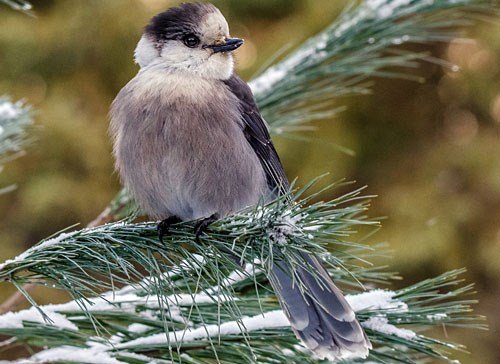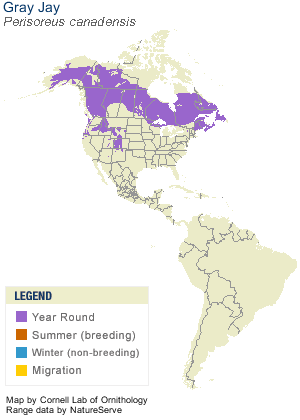Cornell Lab of Ornithology: Decline of Gray Jays in Algonquin Provincial Park, Ontario, Canada
Dr. Ryan Norris and his graduate students study the population of Gray Jays in Algonquin Provincial Park in Ontario, Canada.
The Gray Jay

Image Source
Gray Jays are song birds living year-round in the northern forests of North America and raising chicks in the dark of winter.

Image Source
Gray Jays are highly curious and will eat just about anything. These birds have even been known to grab a raisin or peanut right out of a person's hand.
During the summer months the Gray Jays stash food in trees to sustain them through the winter months.
Algonquin Provincial Park, Ontario, Canada
Image Source
Algonquin Provincial Park established in 1893 is the oldest provincial park in Canada. The park is about 7,653 sq.km. (2,955 sq.mi.) in size. The park encompasses over 2,400 lakes and 1,200 km. of streams and rivers.
Gray Jay Population Study
Dan Strickland started researching the Gray Jay population in Algonquin Provincial Park in the early 1970's.
Dr. Ryan Norris, Associate Professor & University Research Chair Dept of Integrative Biology, University of Guelph, and his team search the park each year to locate new Gray Jay nests. Their research has shown a 50% decline in the population of Gray Jays in the park since the early 1970's.
A changing climate has led to warmer temperatures in the park. Dr. Norris suggests that this is causing the Gray Jay's food caches to spoil which in turn is causing a decline in the survival rate of Gray Jays in the park.
4 minute video of Dr. Norris and his team locating Gray Jay nests (Part One of the research process)
Published by LabofOrnithology on 11 January 2018
Sources
Gray Jay, The Cornell Lab of Ornithology's All About Birds website
LabofOrnithology, YouTube Channel
Nice bird
It's also called the Canada jay or whisky jack. The Royal Canadian Geographical society wanted it to become Canada's national bird.
It is a very interesting bird. I just learned about it today and thought I would share a bit from the article and video I saw it in.
Have a great weekend!
Steem on,
Mike
Wow the video was really amazing just saw that incredible bird
I have always been interested in nature, it`s great that you post a lot of information about birds now, it is very interesting for me to read it and to get new knowledge, especially I like videos in your posts, thanks to them we have an opportunity to watch birds and even their behaviour in usual for them environment.
Es demasiado triste como el cambio climático está afectando la fauna. No solo las aves, hace unos años cuando monitoreaba tortugas marinas, notamos que corrieron su época de anidación y hubo reportes en Chile de animales con hipotermia que estaban saliendo a las playas. Te has convertido en mi hora de reflexión en steemit, gracias por los aportes a la comunidad.
Thank you!!
We live in an ever changing universe on an ever changing planet. The sun cycles, volcanoes, and other events have shaped this world and affected the climate. We know there have been many periods of ice ages in the past followed by warming periods. We live on a dynamic planet and life always find a way.
Have a fantastic weekend!
Steem on,
Mike
the bird is very interesting and lovely so much
Oh how beautiful this bird is! Congratulations very nice shot!
It is an interesting bird. I did not take any pictures of it. All the pictures and video came from Cornell's Lab of Ornithology sites.
Have a fantastic weekend!
Steem on,
Mike
Oh! ok I did not check the source of the picture. I reviewed the post and now I noted it! Thank you for answering! I wish you have a great weekend too!
Maru🌻
Beautiful plumage to fit the surroundings. I've never seen one but I'm not much of a bird watcher. Out in Cali we have blue jays, they can be feisty and like to dive-bomb people and cats.
Fascinating - amazing how this site-specific jay population is being so dramatically impacted by climate change. I wonder if it is the same in other areas where it resides. We have plenty of Scrub Jays here in California! :) Followed you!
I'm also a member of the Cornell Lab, so thanks for spreading the word on their amazing work.
Very happy to have met another member of the Cornell Lab of Ornithology here.
I am far from an expert bird spotter. My background is the hard sciences (physics). I started bird watching because a sparrow nest with chicks was destroyed during the building of my house.
Before the framing of my house was closed in, sparrows built a nest in the spring above the fireplace in my basement. When the builders enclosed the house the nest was destroyed. Because of this I vowed to build a bird feeder site to feed the birds. A small gesture for the loss caused by the building of my house.
The first year no birds showed up at my feeder. I think this was due to the disturbance to the environment caused by the housing development I live in. But after the first year, birds started showing up and I expanded and established my current bird feeder site.
After the first two years, my Mom encouraged me to join Cornell's FeederWatch Project. I have been doing it ever since.
I lived in California before moving here. I lived along the coast in the Los Angeles area for 7 years, but never really paid too much attention to the birds in the area.
I learned about the Gray Jays in a recent YouTube video and the article in the Living Bird magazine produced by Cornell. It was an interesting bird and I thought I would share it with the community.
As one who has lived at a slightly lower latitude than the Gray Jays, I can attest to how the winters have been. Right now it is 12 degrees (F) outside and has been much colder for the past few days.
The last part of my career was spent at a weather agency. Climate change is happening all the time, it is rare for the climate to be stable for long periods of time. Change always seems to bring about hardship for some and opportunities for others.
While the population of Gray Jays is declining now, it is possible this is nature's way of ensuring a hardy genetic pool for the future. Meaning the hardiest of the Gray Jay population will survive and be able to take advantage of the swing toward a colder climate.
Have a fantastic weekend!
Steem on,
Mike
wow so beautiful.